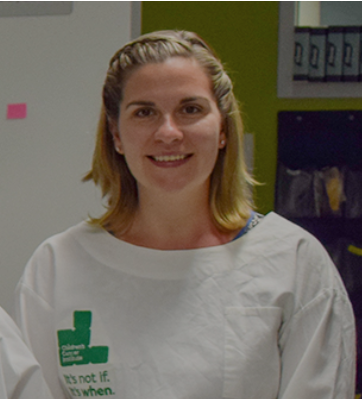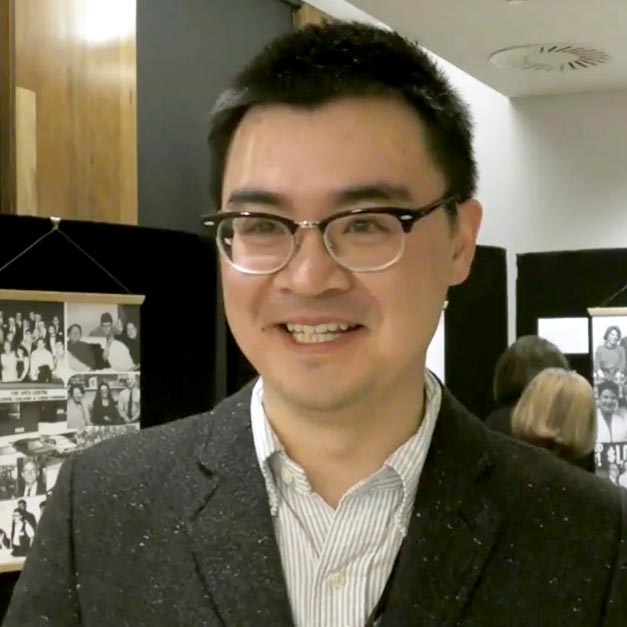Grants
The DIPG / DMG Collaborative has funded $20,022,524 in DIPG/DMG research.
Interested in applying for a grant from the DIPG / DMG Collaborative? Learn more.

Children’s Hospital of Colorado – $200,000
$200,000.00
September 2021
Multimodality, Combination Treatment Strategy for DIPG/DMG
DIPG is an aggressive childhood brain tumor that is nearly always fatal. Although most past patients have died of the tumor pushing on the brainstem’s pons area, DIPG spreads to other parts of the brain and spinal cord, known as the central nervous system (CNS). To cure DIPG, we will need to combine treatment to the main tumor in the pons and the widespread tumor too. We know that radiation treatment to the pons helps temporarily in DIPG but is not enough. We have shown that radiation to the rest of the CNS limits tumor spread, but even this isn’t enough. Chemotherapy has not been effective in the past, but new techniques like injecting medicine directly into the tumor, and new drugs that attack DIPG’s weaknesses, are starting to work. None of these will be enough individually, though. In this project, we will study combinations of radiation and chemotherapy, delivered both to the main tumor and the entire CNS, to find an approach that is most effective against DIPG in mouse models. We will also be developing this combination in parallel as a clinical trial that we believe will mark the beginning of true hope and better survival for patients.
Our past work on a project funded by The Cure Starts Now demonstrated key findings very important to this new project. We showed that even though oral or IV chemotherapy has not worked against DIPG in clinical trials, it can reach the tumor tissue enough to have a potential effect. We also built models in the lab of radiation to the entire CNS and to the pons alone in mice growing human DIPG in the pons. With this model, we showed that radiation to the entire CNS can limit spread of the tumor. Finally, we also built a model of chemotherapy injected directly into the pons and showed that we could get much higher levels of chemotherapy into the tumor than by giving it by IV.
We will now build on this work by studying how we can combine all these treatments together to control both local and widespread DIPG. We have chosen to study medicines that have already shown signs of working in DIPG and are in clinical trials, so that it will be very practical to develop a new combination trial. These medicines are called ONC201, panobinostat, ribociclib, selinexor, and paxalisib. We will use our models of human DIPG growing in a dish, and in the pons of mice, to test lots of combinations of medicines and radiation delivered directly to the tumor and to the whole CNS. We will find the most effective combination and study it in lots of models of DIPG through a network of labs. This combination will then be an excellent candidate to enter a combination clinical trial. At the same time, we will be working with experts in these promising DIPG treatments, as well as various other experts necessary to designing a combination clinical trial, including DIPG families, to build discussion and consensus around a combination approach.
In the past, the way we have finally started to cure previously incurable childhood cancers, like leukemia and neuroblastoma, is through treatment that combines different medicines and different types of treatment. Then, those treatments can be improved continuously to cure more and more patients. Our plan is that this project will mark the first combination treatment in DIPG that starts to truly make a difference in survival and quality of life for DIPG patients. We also hope it will lead to a transition through which new treatments, as they develop through cooperation around the world, are built onto the existing combination so that the survival curve for DIPG can start to rise just like we’ve seen for other childhood cancers.

Children's Cancer Institute – $50,000
$50,000.00
September 2021
Developing Novel Combination Therapies for Diffuse Intrinsic Pontine Glioma
This project will develop novel combination therapies for the most aggressive childhood cancer, diffuse intrinsic pontine glioma (DIPG). Our team performed a comprehensive high-throughput drug screen, testing 3,570 drugs for their ability to prevent DIPG cell growth and found ACT001 to be one of the most effective drugs tested. ACT001 is known to have both antioxidant and anti-inflammatory properties and readily crosses the blood brain barrier. We have initiated a world first Phase 1 pediatric clinical trial of ACT001 for children with relapsed/refractory solid or CNS tumors, including patients with DIPG/DMG. Currently, fifteen patients, seven of which are DIPG/DMG patients, are enrolled and no dose-limiting toxicities have been observed. Excitingly, clinical activity has been demonstrated in three DIPG/DMG patients including improvement in the appearance of the tumor on MRI imaging, as well as improvement in patient symptoms. Using our preclinical models, we now seek to determine precisely how ACT001 works in DIPG and then use this information to evaluate potential ACT001 combination therapies, to enhance the effectiveness of ACT001. As such, this project will provide valuable information for developing new combination treatments that may lead to ACT001 as the first active treatment for children suffering from DIPG.

Cincinnati Children's Hospital – $200,000
$200,000.00
September 2021
Targeting Purine Synthesis and One Carbon Metabolism in DIPG
Diffuse intrinsic pontine glioma (DIPG) is a rare, infiltrative, and incurable brainstem malignancy in children resulting in death within one year from diagnosis. DIPG represents up to 85% of brainstem tumors and has the worst prognosis of all childhood cancers with a five-year overall survival of < 1% (1-5). These tumors are inoperable and surgical biopsies are not common. Being a rare disease (about 300-400 new cases in the US each year), resources and funding are scarce. Lack of surgical options confers particularly poor prognosis and a challenge to study the disease. Genomic studies have identified a recurrent mutation in histone H3 genes that leads to a K27M substitution in the protein and is present in nearly 80% of DIPG (6, 7). The dominant negative effect of the K27M mutation causes global loss of H3K27me3 methylation, interference with the polycomb repressive complex, releasing genes from their repressed state. This is thought to be a major driver for these tumors classifying H3K27M as an oncohistone (7-9). These key studies have substantially contributed to our understanding of the genetic and epigenetic drivers of DIPG. Several clinical trials extrapolated from adult glioma studies have failed to improve survival, and new rationally derived approaches based on our understanding of the disease biology are urgently needed. To better understand the disease and find new drug targets for DIPG that may also be applicable to other pediatric brain tumors, we recently performed for the first time, a thorough analysis of tumor metabolites and compared it to normal human brain cells. Drugs against metabolic targets in kidney cancer and leukemia are in clinical trials. This is a brand new idea in our laboratory. We do not have any publications or major funding on this idea. We have generated the first gene-metabolite interaction map of six DIPG cell lines and compared that with normal human neural stem cell lines. Through bioinformatic and preliminary experimental analysis, we discovered that two key genes in the metabolic pathway that makes the building blocks for DNA and RNA are novel targets in DIPG. We also found that DIPG patient mutations directly regulate these genes. Drugs against these genes are available, and they specifically killed all DIPG cell lines but not normal brain cells. In a pilot study, one drug quadrupled the survival of mice with DIPG compared to mice that didn’t receive treatment. The brain penetration of these drugs is unknown. We will use higher doses of these drugs to examine toxicity, brain penetration and therapeutic efficacy in combination with proton therapy in our preclinical model of DIPG.

UPMC Children's Hospital – $50,000
$50,000.00
September 2021
The Role of QPRT and NAD Pathways in DIPG Treatment Resistance
The proposed study will provide insights into a novel strategy to inhibit energy metabolism as a potential way to tackle treatment-resistant high-grade gliomas (HGGs) and diffuse intrinsic pontine gliomas (DIPGs), the most commonly fatal brain tumors of childhood. This work incorporates our unique resource of treatment-naïve and treatment-resistant models to examine the role of NAD+ (nicotinamide adenine dinucleotide) production, which is critical for energy use in these tumors, and how blocking this process may provide an innovative treatment approach. Our observations, using drugs currently in clinical trials, will define underlying causes of resistance in DIPGs, which has been an ongoing problem for children with these tumors. The intriguing findings of our preliminary studies support a hypothesis that treatment-resistant cells have strong dependence on mediators of NAD+ production, such as the enzyme QPRT (quinolinic acid phosphoribosyltransferase). NAD+-driven pathways, in turn, activate enzymes that are critical for glucose usage, which appears to provide tumor cells with a survival advantage. We seek to identify targets for treatment that can be exploited to improve the chances for cure in children with DIPG and HGG.

University of Queensland Diamantina Institute – $100,000
$100,000.00
September 2021
Innovative Models of the Brain Microenvironment to Identify New Treatments for Medulloblastoma
Brain tumors are the leading cause of disease related mortality in children. Survival rates for children diagnosed with medulloblastoma (MB), the most common malignant pediatric brain tumor, have stagnated for decades. Despite aggressive treatment approaches, a significant proportion of patients relapse, which is almost always fatal. Very little is currently known of the biology and the mechanisms underpinning medulloblastoma relapse. We urgently need a deeper understanding of how tumors relapse and become resistant to therapy to achieve better outcomes for children.
Our preliminary work suggests that tumor-driven changes in the brain microenvironment contribute to MB relapse, in particular the surrounding supportive scaffold and brain vessels. Precisely how tumor cells interact with the dynamically changing tumor microenvironment and blood vessel network and the impact of this on MB response to therapy remains unknown. We are proposing to apply our innovative pre-clinical models to examine the dynamic interactions between MB cells and their environment. This work generates a dramatically improved understanding of how specific environmental cues influence the therapeutic response of MB. Understanding the mechanisms underpinning relapse positions us to identify new drug targets and propose combination therapies that will enhance survival by reducing the likelihood of relapse.

Duke University Hospital – $50,000
$50,000.00
September 2021
Identifying Oncolytic Viral Therapy Resistance Mechanisms in Brain Tumors
Current adjuvant therapy for the malignant brain tumors medulloblastoma (MB) and pediatric high grade glioma (HGG) is marginally effective and often toxic. With standard chemotherapy and radiation, the 5-year overall survival (OS) of MB is 50-80%, however, nearly all patients experience lifelong neurocognitive and endocrine morbidity. The median OS of pediatric HGG is only 19 months. There is currently a profound knowledge gap in understanding how to improve the survival and quality of life in children with MB and HGG. A promising alternative to current radiochemotherapy is oncolytic virotherapy (OV). The polio:rhinovirus chimera, PVSRIPO, and the oncolytic herpes virus (oHSV), G207, are currently in Phase I clinical trials to treat children with MB and HGG. However, the mechanism of oncolysis of these OVs are currently unclear. Furthermore, it is unclear why some patients have durable OS benefits in response to OV, while many patients experience no real benefit.
We have recently discovered that oncolytic viruses cause profound oxidative stress on tumor cells, resulting in robust reactive oxygen species generation and tumor cell lysis. Glutathione (GSH) is a critical cellular anti-oxidant. It appears that OV overwhelms a GSH-mediated anti-oxidant response, resulting in oncolysis. Interestingly, MB and pediatric HGG have starkly similar expression profiles of oxidative stress response genes and is the rationale to study OV in both of these malignant tumor types.
Given that a key mechanism of oncolysis is the induction of profound oxidative stress, we hypothesize that MB and pediatric HGG resistance to OV is mediated by robust anti-oxidant capacity. Given that pro-oxidants deplete GSH, we hypothesize that resistance to OV will be overcome by combining pro-oxidants with OV. Because both wild type Enteroviruses (PVSRIPO) and Herpes viruses (G207) mediate oxidative stress, we hypothesize that resistance mechanisms will be generalizable across these OVs.
The aims of this project are to 1) determine the specific molecular pathways of oxidative stress of MB and pediatric HGG that confer resistance to OV and 2) define oxidative stress modulating agents that overcome resistance to OV for treatment of MB and pediatric HGG. This study will 1) identify oxidative stress response genes that make MB and HGG sensitive resistant to OV, 2) identify oxidative stress response genes that are expressed in response to OV treatment in MB and pediatric HGG, 3) identify genes in human specimens from OV trials that putatively confer resistance to OV, and 4) genetically silence key oxidative stress “resistance” genes to confirm their role in resistance to OV. In parallel, we will 1) identify pro-oxidant agents that overcome OV resistance in vitro and 2) identify which oxidative stress enzymes are effected by pro- and anti-oxidants to identify additional therapeutic targets. This study is impactful because it will elucidate mechanism of resistance to OV and improve the efficacy of OV by harnessing the oxidative stress response.

International DIPG/DMG Registry And Repository - $1,508,198
$1,508,198.00
December 2020
Diffuse intrinsic pontine gliomas (DIPG) are the most common brainstem tumors in children, representing approximately 75-80% of all pediatric brainstem tumors. Approximately 200-300 patients are diagnosed with DIPG North America and a similar number in Europe. DIPG accounts for 10-15% of all new pediatric brain tumor diagnoses and is the leading cause of brain tumor-related death in children. The median age at diagnosis is 6 to 7 years with a median survival of less than 1 year. Although radiotherapy does improve neurological function and survival by 2-3 months, no effective chemotherapeutic regimens are currently available. The International Diffuse Intrinsic Pontine Glioma/Diffuse Midline Glioma Registry (IDIPG/DMGR) represents the largest and most comprehensive collection of linked clinical, radiologic, pathologic and gemomics data from a diverse cohort of DIPG patients available to researchers throughout the world. With the generous support of a coalition of pediatric brain tumor foundations forming the DIPG Collaborative, and collaborations with 113 academic medical centers in 15 countries, the IDIPG/DMGR continues to expand. From April 2012 to December 2019, 1086 patients diagnosed with DIPG have been enrolled. The radiology repository contains 5405 studies from over 700 patients. Images from 589 patients have been centrally reviewed. The pathology repository contains 3562 specimens on 125 patients. Sixty-two autopsies have been coordinated by the IDIPGR. Fresh DIPG tissue from 20 autopsies has been sent to investigators to develop primary cell cultures. Five primary cell lines have been established. 199 genomic data sets are available including whole genome, whole exome, and/or RNA seq, and methylation. Investigators from around the world are currently conducting 20 projects using data/tissue from the DIPG/DMG Registry. Six additional studies have been published. In 2019, the steering committee of the IDIPGR approved the expansion of the Registry to include patients with diffuse midline gliomas. The first 11 patients with DMG have now been enrolled in the IDIPG/DMG Registry.

Children's Cancer Institute - $99,251
$99,251.00
September 2020
Discovering New Epigenetic Players in DIPG Oncogenesis
Diffuse intrinsic pontine glioma (DIPG) is the most aggressive brain tumour in children. DIPG accounts for 10-15 percent of all paediatric central nervous system tumours. Every year in US 300 children are diagnosed with DIPG and 300 children will die of this disease. By conducting fundamental research, we will investigate companion proteins, called epigenetic factors, of H3.3K27M, the most prevalent mutation found in DIPG, that contribute to the development of this cancer. Despite the fact that these protein partners are key to the normal functioning of H3.3 and have been link to other cancers, they have never been investigated in the context of DIPG. This study will lead to the identification of new therapeutic targets tailored for DIPG, an urgent need of this disease.
2021 Research Update - The H2A.Z-nuclesome code in mammals: emerging functions

Northwestern Memorial Hospital - $110,000
$110,000.00
September 2020
Development of Histone Demethylase Inhibitor Against DIPG
For a child is diagnosed with a diffuse intrinsic pontine glioma so called DIPG, the options for treatment are scarce and so are the chances for survival. This aggressive brain tumor generally strikes children who are 6 years old and younger, with most surviving less than two year after diagnosis. DIPG has a specific gene mutation, leads to change a function of DNA binding protein, histone. This gene mutation thought to be a specific therapeutic target that
could be used to make new effective drugs to help kids with DIPG get better. We recently showed that the drug targeting specific histone enzyme, named GSK-J4, delay tumor growth and increase survival of mice implanted human DIPG cells. Because of its promising anti-tumor activities, GSK-J4 has been used to treat many kinds of tumors in animal models including leukemia, lymphoma, prostate and gastric cancer, and DIPG; however, GSK-J4 is not yet in clinical development for treating patients. The major challenge for GSK-J4 in clinical development is that GSK-J4 is a drug that is rapidly changed to the active drug GSKJ1, which has limited to enter the tumor cells in the brain. We have developed a novel compound that is derived from GSK-J1, named UR-8, as a lead anti-cancer compound through our drug screening. UR-8 has showed selective cytotoxic activity against human DIPG cells and apparently transported to the brain with a useful extent based on its in vivo stability and effectiveness. UR-8 showed greater anti-tumor activity and survival benefit than that obtained by GSK-J4 treatment in human DIPG animal models. Based on the observation of this lead compound, UR-8, we will further develop new drugs which are similar to GSK-J4/J1 to increase the potency, specificity, and brain transport features. We will test cytotoxicity and assess safety and tolerability of new compounds in DIPG mouse models.
Our long-term goal is to use new compounds in combination with radiation which is used routinely for the treatment of DIPG patient. We will treat DIPG mouse models with a new compound alone or in combination with radiation. Our basic drug discovery, in combination with therapeutic testing in animal models, in turn, will therefore provide insights for testing a novel therapeutic approach for treating currently incurable pediatric brain tumors.

The Hospital for Sick Children - $100,000
$100,000.00
September 2020
Methionne Deptrivation as a Therapeutic Strategy for Diffuse Intrinsic Pontine Glioma
After decades of clinical trials, no effective treatment has yet been found for DIPG. While we now know a lot about the genetics of this disease, this has unfortunately not thus far led to improved survival for children with DIPG. To better understand the disrupted pathways in DIPG we performed an analysis of their proteins and how these differed from normal brain. One of the interesting pathways that came up was the methionine (an essential amino acid) metabolism pathway. We then tested DIPG patient cells and found that they are particularly sensitive to methionine withdrawal. Here we propose to test the effects of methionine deprivation on cell survival, death, and proliferation as well as methionine metabolism of DIPG cells. We will then test the ability of methionine deprivation to prolong survival in mice harboring DIPG either alone, or together with radiation. We will learn why low methionine levels are detrimental to cancer cells and tolerable to normal cells and how this can be utilized therapeutically. Low methionine diets are very tolerable to humans and are similar to a vegan diet thus this method is readily transferable to the clinic without extended drug approval requirement and expense. Methionine dependency has never before been studied in DIPG and represents a novel approach to therapeutically target DIPG.

Hunter Medical Research Institute - $145,640
$145,640.00
September 2020
Combatt DMG: Combined Anti-tumor Targeting of Diffuse Midline Gliomas
Paediatric high-grade glioma of the brainstem – diffuse midline glioma (DMG), represent the most aggressive primary tumor of the central nervous system (CNS) and are responsible for half of all brain cancer deaths in children. Recent scientific advances provide much needed insight into the biology of the disease – particularly the genetic characteristics of patient biopsies and autopsies, providing clues regarding the gene mutations that influence cancer growth, and the ability of the tumor to continue to grow, or to sidestep, despite drug treatment. However, the specific knowledge of the mechanisms underpinning how the tumor moves and grow among and through normal brain structures, is still unknown.
Our group shows the drug ‘paxalisib’ (which readily crosses the blood brain barrier) potently inhibits ‘PI3K/Akt/mTOR' – a cell communication axis that influences growth, proliferation and that contributes to energy production. Profiling the activity of proteins (phosphoproteomics) in DMG tumor cells following treatment with paxalisib, identified that the tumor amplified communication (Protein kinase C - PKC) pathways that activate migratory and infiltrative growth dissemination (‘diffuse’/’intrinsic’, hallmarks of DMG). These finding led us to test the hypothesis that dual targeting of PI3K/Akt/mTOR and PKC has the potential to improve outcomes for DMG patients by stopping proliferative and infiltrative growth.
For the first time, we have subjected DMG cells to global phosphoproteomic profiling, +/- treatment with paxalisib and rapamycin (mTOR inhibitor), to expose the signalling pathways responsible for continued growth, survival and ultimately the development of treatment resistance. Our efforts sought to identify which of the spectrum of pathways become over-activated in patients following PI3K inhibition, in the hope that these pathways could be simultaneously targeted at diagnosis and/or at disease progression and/or as a drug target when resistance occurs. All DMG cell lines were sensitive to paxalisib (0.197-1.128 IC ); with biochemical investigations confirming potent inhibition of PI3K/Akt signaling. However, PI3K or mTOR inhibition potently activated PKC, and downstream proteins that control the dynamic remodeling of the actin cytoskeleton that influence cell motility, alter cell polarity and drive invasion of the tumor; aiding escape from radiation therapy, and in this case, PI3K and mTOR inhibition.
Targeting the PI3K/Akt/mTOR pathway is an approach that has been trialed in many cancers. The pathway is recognized as one of the most overactive growth, proliferation, cellular metabolism pathways in cancer, however, this strategy has yielded little clinical benefit, as therapy resistance quickly develops. The PI3K/AKT/mTOR pathway also plays a pivotal role in the metabolic and mitogenic (cell division) actions of insulin produced in response to increased blood sugar levels. The catalytic enzyme of the PI3K signalling axis, ‘PIK3CA’, is frequently mutated in DMG (PI3KR1, PTEN, MTORC1, TSC1 also).
This is particularly important in DMG, as corticosteroids prescribed to attempt to control hallmark peritumoural inflammation and hydrocephalus have strong affinity for glucocorticoid receptors (so termed "glucocorticoids") which reduce inflammation, but also impact on glucose homeostasis, increasing blood glucose levels and stimulating appetite.
Recently, blood glucose and insulin levels were monitored in mice treated with several PI3K/Akt inhibitors (paxalisib excluded) currently in human clinical trials and showed PI3K inhibitors elevated blood glucose and insulin levels.
Furthermore, injection of insulin abrogated the antitumor efficacy of PI3K inhibitors in mice harboring PI3K-mutant breast cancers. These results, coupled with our identification of PKC activation in response to PI3K inhibition, provide a
mechanistic link that underpins resistance to PI3K/Akt/mTOR inhibitors in DMG that warrants rigorous investigation.
Our poilot data showed high-level synergistic cell death in 88% of DMG cell lines when treated with PI3K inhibitors in combination with PKC inhibitors, FDA approved to treat other cancers. Assessment of the level of PKC signaling in untreated DMG cell lines, revealed overactivation in 85% of cell lines; with the highest level of activation seen in patient samples harboring H3.3K27M mutations, linked with shortened overall survival compared to DMG patients diagnosed with H3.1K27M mutations or wildtype H3. In hindsight this is unsurprising: these high-grade gliomas, which originate in the pontine region of the brainstem, frequently disseminate into other midline structures (thalamus) and the cerebellum.
This project builds on strong pilot data, showing the important role of proteins that influence dynamic cellular remodeling, driving growth and migration into surrounding and distant tissues in advanced disease. Using complementary molecular (CRISPR-cas9 and shRNA), and pharmacological studies, coupled with sophisticated and
quantitative protein sequencing technologies, cell biology techniques and pre-clinical models, we will assess the functional role of PKC and activated actin cytoskeleton remodeling proteins, that influence cell motility, cell polarity, to drive invasion of the tumor; to aid in escape from radiation and emerging targeted therapies. This project will determine whether simultaneous targeting of growth/proliferation/metabolic pathways in combination with cell motility pathways is a treatment paradigm that will improve outcomes for patients.

International DIPG/DMG Registry And Repository - $862,671
$862,671.00
May 2020
Diffuse intrinsic pontine gliomas (DIPG) are the most common brainstem tumors in children, representing approximately 75-80% of all pediatric brainstem tumors. Approximately 200-300 patients are diagnosed with DIPG North America and a similar number in Europe. DIPG accounts for 10-15% of all new pediatric brain tumor diagnoses and is the leading cause of brain tumor-related death in children. The median age at diagnosis is 6 to 7 years with a median survival of less than 1 year. Although radiotherapy does improve neurological function and survival by 2-3 months, no effective chemotherapeutic regimens are currently available. The International Diffuse Intrinsic Pontine Glioma/Diffuse Midline Glioma Registry (IDIPG/DMGR) represents the largest and most comprehensive collection of linked clinical, radiologic, pathologic and gemomics data from a diverse cohort of DIPG patients available to researchers throughout the world. With the generous support of a coalition of pediatric brain tumor foundations forming the DIPG Collaborative, and collaborations with 113 academic medical centers in 15 countries, the IDIPG/DMGR continues to expand. From April 2012 to December 2019, 1086 patients diagnosed with DIPG have been enrolled. The radiology repository contains 5405 studies from over 700 patients. Images from 589 patients have been centrally reviewed. The pathology repository contains 3562 specimens on 125 patients. Sixty-two autopsies have been coordinated by the IDIPGR. Fresh DIPG tissue from 20 autopsies has been sent to investigators to develop primary cell cultures. Five primary cell lines have been established. 199 genomic data sets are available including whole genome, whole exome, and/or RNA seq, and methylation. Investigators from around the world are currently conducting 20 projects using data/tissue from the DIPG/DMG Registry. Six additional studies have been published. In 2019, the steering committee of the IDIPGR approved the expansion of the Registry to include patients with diffuse midline gliomas. The first 11 patients with DMG have now been enrolled in the IDIPG/DMG Registry.

Sydney Children's Hospital - $151,468
$151,468.00
December 2019
Developing New Epigenetic Combination Treatments Against DIPG.
Diffuse intrinsic pontine glioma (DIPG) is the most aggressive of all childhood cancers. Standard treatment with radiotherapy is only palliative and single drug chemotherapy is ineffective. We have found that DIPG cells are sensitive to a novel anticancer treatment. CBL0137 is a novel class of anticancer agents that can inhibit the action of a key protein complex called Facilitates Chromatin Transcription (FACT). The FACT complex controls multiple cancer –associated pathways that can lead to aberrant tumor growth. We have found that CBL0137 can inhibit further the growth of DIPG tumors when combined with other anticancer drugs such as panobinostat and JQ1. Furthermore preliminary testing has shown that CBL0137 can also be combined with other chemotherapeutic agents such as olaparib and ACT001. Olaparib is a clinically approved agent for ovarian and breast cancers where as ACT001 is currently in Phase 1 testing in pediatric patients with DIPG. In this project, we aim to develop these new combination therapy strategies in preclinical models of DIPG and obtain the necessary quantum of data to begin the transition of CBL0137 therapy from the bench to the bedside to directly benefit children with this devastating and currently incurable tumor.

University of Sydney - $100,000
$100,000.00
November 2019
Targeting hypoxia and mitochondrial metabolism with repurposing drugs as an approach of radiosensitization for diffuse intrinsic pontine gliomas.
Diffuse intrinsic pontine glioma (DIPG) is a rare and incurable brain tumor that arises in the brainstem of children predominantly between the ages of 6 and 9. Unlike many brain tumors, DIPGs cannot be removed through surgery due to its sensitive location. The standard of care today remains radiation therapy (RT) alone. Unfortunately, almost all DIPGs recur locally within 12 months secondary to radioresistance. Therefore, it is important to understand the mechanisms of radioresistance, as this may be used to improve the radiosensitivity and offer a pathway to the development of novel therapies for this deadly brain tumor. Hypoxia, a condition in which the body is deprived of adequate oxygen supply at the tissue level, is a common microenvironmental feature of all solid tumors, playing a vital role in radioresistance. Recent reports showed that DIPGs are exposed to a hypoxic microenvironment, suggesting targeting of hypoxia may be effective to improve their radiosensitivity. My preliminary data have shown that the radiosensitivity of DIPG cells was significantly improved when treated with biguanide, a class of diabetes drug that can reduce hypoxia, and this radiosensitising effect was further improved when a second drug was combined to further modulate sugar metabolism. These findings could potentially form the basis for pharmaceutically targeting hypoxia and tumor metabolism as a new radiosensitising treatment for incurable DIPG. Children currently diagnosed with DIPG have no hope of cure and are offered palliative treatment only. RT is the only effective treatment for DIPG to date although it only provides relief of tumor-related symptoms in roughly 70% patients. However, all DIPGs recur locally secondary to radioresistance, thus improving the effect of RT remains the most promising avenue to better outcomes in DIPG patients. Cells under hypoxia, a condition where the tissues do not have enough oxygen supply, are 2-3 times more resistant to RT than cells that are well oxygenated at the time of irradiation [1]. A recent study reported that DIPG cells are exposed to a hypoxic microenvironment, suggesting these cells are intrinsically resistant to RT [2]. These findings also suggest that targeting hypoxia may be an effective strategy to overcome the radioresistance of DIPG cells. Biguanides (metformin/phenformin) are a class of drugs that are currently used in clinic for the treatment of Type II diabetes. Apart from lowering blood sugar level, biguanides can also reduce the oxygen consumption of cells by targeting mitochondria, the rod-shaped organelles that can be considered the power generators of cells. By lowering tumor demand for oxygen, the hypoxic condition can thus be lessened. In our pilot studies, we have observed that metformin largely improved the efficacy of RT in a mouse model carrying DIPG cells in their brains. This exciting result led us to further optimize this strategy such that a better efficacy can be achieved. Given metformin is reliant on certain transporters to enter tumor cells [3], we proposed to use a similar drug phenformin as it does not rely on those transporters to enter cells [4], thereby allowing higher drug concentration in tumor cells. Strikingly, phenformin is ~30 times stronger than metformin to slow the growth of DIPG cells. Phenformin reduced oxygen consumption rate which in turn increased lactic acid production. Given high level of lactic acid is the primary adverse effect of phenformin and strongly correlates with poor clinical outcome, a strategy is thus needed to counteract this unfavorable side effect. Dichloroacetate (DCA), a compound that lowers blood lactic acid levels, was selected to offset this side effect, not only because it is an orphan drug to treat high level of lactic acid, it is also well tolerated by children [5]. When DCA was combined with phenformin, the high level of lactic acid production was largely blocked. Surprisingly, the combination also led to a much stronger cell killing effect by depriving tumor cells of energy supply and damaging their DNA. Moreover, the combination also reduced the level of two master regulators that collaboratively enhance the cancer cell growth/survival and metabolic needs through increased uptake of sugar and contribute significantly to radioresistance. When RT was combined with phenformin and DCA, the most effective activity was observed, with the triple combination leading to the lowest number of surviving DIPG cells. More importantly, both phenformin and DCA can readily cross blood-brain-barrier (BBB), have long been used in clinics, and are very well tolerated by young children. Therefore, they are the drugs with the most amount of testing and closest to being tested in clinical trials. Given the results generated from this project will be rapidly translated to clinic and benefit children with DIPG, the anticipated impact of this research project is of great significance: it may lead to a change in treatment regimen resulting in longer survival rates for the pediatric patients with newly diagnosed DIPG.

University of Michigan Hospitals - $157,856
$157,856.00
November 2019
Therapeutic reversal of pre-natal pontine ID1 signaling in DIPG
Diffuse intrinsic pontine glioma (DIPG) is a lethal pediatric brain tumor wand few children with this diagnosis survive up to two years. Even with the advent of precision-based medicine, experimental therapies have yet to show benefit beyond standard radiation, highlighting the dire need to identify and investigate novel genetic therapeutic targets in DIPG. DIPG researchers now know that the patterns of mutations driving the growth of DIPG are unique, when compared to other childhood tumors and adult high-grade gliomas. As many as 85% of DIPGs harbor mutations in histone H3 variant H3.3, coded for by the H3F3A gene – and our work and others have shown that this mutation results in critical changes in tumor biology. It is therefore necessary to consider H3.3 mutational status when investigating novel therapeutic targets and pathways for DIPG.
Recent work by our collaborative team has demonstrated a critical genetic target in DIPG, inhibitor of DNA binding 1 (ID1). Inhibitor of DNA binding (ID) proteins are key regulators of pre-natal tissue growth and its regulation has been tied to the pathogenesis of many diseases including DIPG. Our lab has exciting preliminary data that DIPG tumor cells re-activate ID1 signaling that was used pre-natally to build the normal pons, resulting in many of the most aggressive features in DIPG. We have also found that cannabidiol (CBD), the non-toxic and non-psychoactive member of the endocannabinoid family found in Cannabis Sativa, can reduce ID1 levels and the viability of DIPG tumor cells in vitro. In order to define ID1 as a therapeutic target in a clinically relevant manner, it is important to establish whether ID1 can be effectively targeted in mouse models of DIPG and to understand how ID1 signaling may be regulated in different H3.3 mutational subgroups.
The experiments outlined in this protocol will answer meaningful questions about the mechanism underlying ID1-driven DIPG invasion and potentially open novel therapeutic avenues. In particular, the possible use of CBD therapy to target the ID1 pathway in DIPG is a clinically relevant but scientifically unexplored question in DIPG.